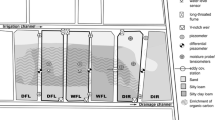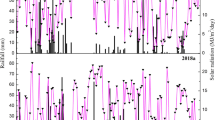Abstract
The widely adopted alternate wetting and drying (AWD) irrigation for rice production is increasingly needed to quantify the different water outflows and nitrogen leaching losses. We investigated the effects of AWD on percolation, water productivity, nitrogen leaching losses, and nitrogen productivity through in situ experiments. Results show that AWD reduced irrigation water without a significant impact on grain yields and increased the mean water productivity by 16.9 % compared with continuously flood irrigation (CFI). The mean nitrogen productivity of 135 kg ha−1 N level was 22.2 % higher than that of 180 kg ha−1 N level, although grain yields substantially increased because of nitrogen fertilization application. The percolation was also reduced by 15.3 % in 2007 and 8.3 % in 2008 compared to CFI. However, the cumulative percolation of the first 5 days after irrigation in AWD plots is significantly larger than that in CFI plots. The NH4 +–N and TN leaching losses of AWD and CFI had no significant variations while the NO3 −–N leaching losses were increased caused by AWD. The total NH4 +–N, NO3 −–N, and TN leaching losses of AWD in the first 3 days after irrigation were higher than that of contemporaneous CFI. The results indicate that the bypass or preferential flow and strengthened nitrification–denitrification nitrogen transformation processes because of alternate wetting and drying potentially decrease the water saving effectiveness and increase the NO3 −–N loading to the groundwater.





Similar content being viewed by others
References
Alberto MCR, Wassmann R, Hirano T, Miyata A, Hatano R, Kumar A, Padre A, Amante M (2011) Comparisons of energy balance and evapotranspiration between flooded and aerobic rice fields in the Philippines. Agric Water Manag 98(9):1417–1430
Belder P (2004) Effect of water-saving irrigation on rice yield and water use in typical lowland conditions in Asia. Agric Water Manag 65(3):193–210
Belder P, Spiertz J, Bouman B, Lu G, Tuong T (2005) Nitrogen economy and water productivity of lowland rice under water-saving irrigation. Field Crop Res 93(2–3):169–185
Belder P, Bouman B, Spiertz J (2007) Exploring options for water savings in lowland rice using a modelling approach. Agric Syst 92(1–3):91–114
Borken W, Matzner E (2009) Reappraisal of drying and wetting effects on C and N mineralization and fluxes in soils. Global Change Biol 15(4):808–824
Bouman BAM, Tuong TP (2001) Field water management to save water and increase its productivity in irrigated lowland rice. Agric Water Manag 49:11–30
Bouman B, Feng L, Tuong T, Lu G, Wang H, Feng Y (2007a) Exploring options to grow rice using less water in northern China using a modelling approachII. Quantifying yield, water balance components, and water productivity. Agric Water Manag 88(1–3):23–33
Bouman B, Humphreys E, Tuong T, Barker R (2007b) Rice and water. Adv Agron 92:187–237
Bowman RS, Rice RC (1986) Transport of conservative tracers in the field under intermittent flood irrigation. Water Resour Res 22(11):1531–1536
Broadbent F (1971) Losses of nitrogen from some flooded soils in tracer experiments. Soil Sci Soc Am J 35(6):922–926
Buresh R, Castillo E, Datta S (1993) Nitrogen losses in puddled soils as affected by timing of water deficit and nitrogen fertilization. Plant Soil 157(2):197–206
Cabangon RJ, Tuong T (2000) Management of cracked soils for water saving during land preparation for rice cultivation. Soil Tillage Res 56(1–2):105–116
Cabangon R, Castillo E, Bao L, Lu G, Wang G, Cui Y, Tuong T, Bouman B, Li Y, Chen C (2001) Impact of alternate wetting and drying irrigation on rice growth and resource-use efficiency. In: Barker R, Loeve R, Li YH, Tuong TP (eds) Proceedings of an International Workshop, Wuhan, China, 2001. Water-saving irrigation for rice, International water management institute, Colombo, pp 55–79
Cabangon RJ, Tuong TP, Castillo EG, Bao LX, Lu G, Wang G, Cui Y, Bouman BAM, Li Y, Chen C, Wang J (2004) Effect of irrigation method and N-fertilizer management on rice yield, water productivity and nutrient-use efficiencies in typical lowland rice conditions in China. Paddy Water Environ 2(4):195–206
Chowdary V (2004) A coupled soil water and nitrogen balance model for flooded rice fields in India. Agric Ecosyst Environ 103(3):425–441
Feng L, Bouman B, Tuong T, Cabangon R, Li Y, Lu G, Feng Y (2007) Exploring options to grow rice using less water in northern China using a modelling approach I. Field experiments and model evaluation. Agric Water Manag 88(1–3):1–13
Garg KK, Das BS, Safeeq M, Bhadoria PBS (2009) Measurement and modeling of soil water regime in a lowland paddy field showing preferential transport. Agric Water Manag 96(12):1705–1714
Gordon H, Haygarth PM, Bardgett RD (2008) Drying and rewetting effects on soil microbial community composition and nutrient leaching. Soil Biol Biochem 40(2):302–311
Gun Won J, Soo Choi J, Phil Lee S, Ho Son S, Ok Chung S (2005) Water saving by shallow intermittent irrigation and growth of rice. Plant Prod Sci 8(4):487–492
Islam M, Parul S, Pathan A, Quasem M, Islam M (2004) Influence of cracking on rice seasons and irrigation in Bangladesh. J Biol Sci 4(1):11–14
Janssen M, Lennartz B (2007) Horizontal and vertical water and solute fluxes in paddy rice fields. Soil Tillage Res 94(1):133–141
Janssen M, Lennartz B (2008) Characterization of preferential flow pathways through paddy bunds with dye tracer tests. Soil Sci Soc Am J 72(6):1756–1766
Janssen M, Lennartz B (2009) Water losses through paddy bunds: methods, experimental data, and simulation studies. J Hydrol 369(1–2):142–153
Jin J, Yang JP (2004) Effect of nitrogen leaching of paddy field with split application under soil fertility conditions. J Soil Water Conserv 18(3):98–101 (in Chinese)
Kao YH, Liu CW, Jang CS, Zanh SW, Lin KH (2010) Assessment of nitrogen contamination of groundwater in paddy and upland fields. Paddy Water Environ 9(3):301–307
Katsura K, Okami M, Mizunuma H, Kato Y (2010) Radiation use efficiency, N accumulation and biomass production of high-yielding rice in aerobic culture. Field Crop Res 117(1):81–89
Kirby J, Ringrose-Voase A (2000) Drying of some Philippine and Indonesian puddled rice soils following surface drainage: numerical analysis using a swelling soil flow model. Soil Tillage Res 57(1–2):13–30
Li YH (2001) Research and practice of water-saving irrigation for rice in China. In: Barker, R, Loeve, R, Li, Y, Tuong, TP (Eds), Proceedings of an international workshop on water-saving irrigation for rice, Wuhan, pp 135–144, 23–25 March
Li Y, Barker R (2004) Increasing water productivity for paddy irrigation in China. Paddy Water Environ 2:187–193
Li H, Li M (2010) Sub-group formation and the adoption of the alternate wetting and drying irrigation method for rice in China. Agric Water Manag 97(5):700–706
Lu J, Ookawa T, Hirasawa T (2000) The effects of irrigation regimes on the water use, dry matter production and physiological responses of paddy rice. Plant Soil 223(1):209–218
Maruyama T, Tanji K (1997) Physical and chemical processes of soil related to paddy drainage. Shinzan-Sha Sci & Tech Publishing Co, Ltd, Tokyo, pp 229
Mikha MM, Rice CW, Milliken GA (2005) Carbon and nitrogen mineralization as affected by drying and wetting cycles. Soil Biol Biochem 37(2):339–347
Moya P, Hong L, Dawe D, Chongde C (2004) The impact of on-farm water saving irrigation techniques on rice productivity and profitability in Zhanghe irrigation system, Hubei, China. Paddy Water Environ 2(4):207–215
Mushtaq S, Dawe D, Lin H, Moya P (2006) An assessment of the role of ponds in the adoption of water-saving irrigation practices in the Zhanghe irrigation system, China. Agric Water Manag 83(1–2):100–110
Oostindie K, Bronswijk J (1995) Consequences of preferential flow in cracking clay soils for contamination-risk of shallow aquifers. J Environ Manag 43(4):359–373
Peng SZ, Yang SH, Xu JZ, Luo YF, Hou HJ (2011) Nitrogen and phosphorus leaching losses from paddy fields with different water and nitrogen managements. Paddy Water Environ 9(3):333–342
Sah RN, Mikkelsen D (1983) Availability and utilization of fertilizer nitrogen by rice under alternate flooding II. Effects on growth and nitrogen use efficiency. Plant Soil 75(2):227–234
Tabbal DF, Bouman BAM, Bhuiyan SI, Sibayan EB, Sattarc MA (2002) On-farm strategies for reducing water input in irrigated rice; case studies in the Philippines. Agric Water Manag 56:93–112
Tsubo M, Fukai S, Basnayake J, Tuong TP, Bouman B, Harnpichitvitaya D (2005) Estimating percolation and lateral water flow on sloping land in rainfed lowland rice ecosystem. Plant Prod Sci 8(3):354–357
Tuong TP, Bouman BAM, Mortimer M (2005) More rice, less water-integrated approaches for increasing water productivity in irrigated rice-based systems in Asia. Plant Prod Sci 8(3):231–241
Vial LK (2007) Aerobic and alternate-wet-and-dry (AWD) rice systems. A report for Nuffield Australis Farming Scholars. Nuffield Australia, Rabobank, p 45
Wang M, Chen ZW, Yang JP, Xu W, Ge CS, Chen WY (2009) Measurement difference in paddy field nitrogen leakage by using different type lysimeters. J Appl Ecol 20(5):1236–1242 (in Chinese)
Yang C (2004) Rice root growth and nutrient uptake as influenced by organic manure in continuously and alternately flooded paddy soils. Agric Water Manag 70(1):67–81
Zhi M (1993) Study on evaluation of irrigation performance in China. Maintenance and operation of irrigation/drainage scheme and improved performance. In: Proceedings of Asian Regional Symposium, Beijing, pp 6–35
Acknowledgments
The study was financially supported by the Specialized Research Project funds for Public Welfare Sector of Ministry of Water Resources (Nos. 201001003, 201001079, 201001003-6), the Fundamental Research Funds for the Central Universities (No. 206274407), and the National Key Technologies R&D Program of China during the 12th Five-year-Plan Period (No. 2012BAD08B05).
Author information
Authors and Affiliations
Corresponding author
Rights and permissions
About this article
Cite this article
Tan, X., Shao, D., Liu, H. et al. Effects of alternate wetting and drying irrigation on percolation and nitrogen leaching in paddy fields. Paddy Water Environ 11, 381–395 (2013). https://doi.org/10.1007/s10333-012-0328-0
Received:
Revised:
Accepted:
Published:
Issue Date:
DOI: https://doi.org/10.1007/s10333-012-0328-0




